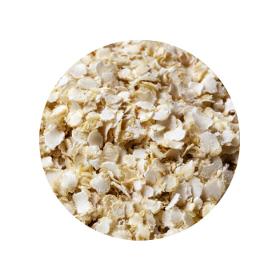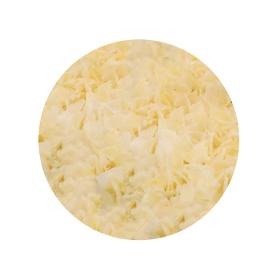- europages
- >
- COMPANIES - SUPPLIERS - SERVICE PROVIDERS
- >
- flaking
Results for
Flaking - Import export

VEHGRO B.V
Germany
"Origin of Buckwheat Buckwheat flakes come from the buckwheat (Fagopyrum esculentum), a plant that flourishes in countries around the world. Buckwheat has white to pink flowers. Buckwheat can be used for breakfast, is suitable for baking biscuits, contains many carbohydrates and is easy to digest. It is thought that buckwheat has its origins in China and there was first grown around 1000 BC. In the 15th century Europe was also acquainted with buckwheat. For more information on this product, please refer to the following page: Article Buckwheat Processing Buckwheat Flakes The hulled seeds of the buckwheat plant are first well washed and placed on trays. Then the seeds germinate under controlled temperature and humidity for 24 to 48 hours, or until the germ is fully developed. These developed germs are moved to different trays and dried at …"
Request for a quote
VEHGRO B.V
Germany
"History and Origin of Quinoa Quinoa (Chenopodium quinoa) is native to South America and has been grown as the main food crop since 6000 years ago. Quinoa was already used by the Incas as a field product. The plant is able to grow under cold, nutrient-poor and dry conditions. The growth period is about 5-6 months. Through crossbreeding, quinoa varieties have been created which can grow in European and North American conditions. In the first half of April the quinoa is sown in Europe and the harvest takes place from mid-September. Production Process Quinoa Flakes After harvest, the quinoa is first cleaned. Then the quinoa is washed to remove the saponin. Then it is dried and the best pieces will be selected by hand. These pieces are soaked to flatten the quinoa. After drying, the quinoa is sieved and then processed into quinoa flakes. Healthy properties Quinoa Flakes <Quinoa flakes are rich in vitamins B2, E, iron, copper and magnesium. Quino…"
Request for a quote
VEHGRO B.V
Germany
"Organic Potato Flakes The potato (solanum tuberosum) is a plant that grows underground. The potato originally comes from South America, but nowadays it is grown in many European countries. Potatoes are cut and dried after harvesting, leaving flakes. Potato Purée Potato flakes are flat pieces of dried potato purée. The potatoes are first boiled and then mashed, after which they are flattened by large rollers in a drum. Because the potato flakes are quickly dried to the desired moisture content, the dried mashed potato flakes are then scraped off the drum and broken through a mill sieve. Because the flakes easily absorb (cold) water , these potato flakes are often used in food products. The potato starch retains its high absorption capacity because the flakes are rapidly dehydrated."
Request for a quote
VEHGRO B.V
Germany
"Origin of the Coconut The coconut (Cocos nucifera) comes from the coconut palm. Coconut palms grow mainly in tropical countries. The fruit of the coconut is found in a green husk. After the removal of the green part, what remains is the hairy, brown and wooden nut. The brown ball has a diameter of 10 to 15 centimetres and contains the white flesh. Coconuts were first cultivated in Southeast Asia and today most coconuts come from Indonesia, Filepines and India. Processing into Coconut Flakes After harvesting, the green outer shell of the coconut is removed. Then the white pulp is cleaned and removed from the brown shell. The pulp is then sterilized and cut into pieces, after which it can go into the oven to dry. After this process, the pulp is processed into coconut flakes. Use of Coconut Flakes The coconut flakes have a typical milky and sweet taste. They are crunchy and sweet and pleasant aroma. The coconut flakes are very suitable as a garnis…"
Request for a quote
VEHGRO B.V
Germany
"Origin Indian Sun Flakes Our Indian sun flakes are extracted from a salt dome located in seawater, in north-east India. For our sun flakes, pure and clear seawater from the Indian Ocean is pumped into evaporation basins. On warm and windy days, the evaporation of the seawater causes small salt flowers to form on the surface of the water, resembling a fine layer of ice. This moist Fleur de Sel is skimmed by hand using a wooden spoon. In order to turn the moist Fleur de Sel into our snow-white solar flakes, the freshly harvested salt is dried under glass plates and under the influence of the sun. The resulting white and very dry salt flakes are similar to Murray River salt. Use The Indian sun flakes get their exceptionally mild taste from the ratio of calcium to magnesium. Due to its special structure, it is a waste to use this salt during cooking. It is better to use the salt as a 'finishing touch' in the finishing and/or decoration of different kinds o…"
Request for a quoteDo you sell or make similar products?
Sign up to europages and have your products listed

VEHGRO B.V
Germany
"Flakes of oat In order to make oat flakes, the whole grain is used. So including the bran and germ and not just the starch part of the grain. Oat flakes are therefore always whole grain. Oat flakes are easier and quicker to prepare than the whole grain of oats. As well as being easier to digest. Important reasons why oat flakes are so popular. Benefits of Oat Flakes Oat flakes provide your body with a lot of vitamins. they give you the strength you need to get through the day and satiate your appetite. Oat flakes has many other benefits: they are cholesterol-lowering, a source of antioxidants, provide your body with a lot of energy and they are diuretic. This nutritious oats is delicious in the yogurt, for example, as breakfast. It supports good tooth and bone formation and is also easily digestible."
Request for a quoteResults for
Flaking - Import exportNumber of results
7 ProductsCountries
Company type
Category